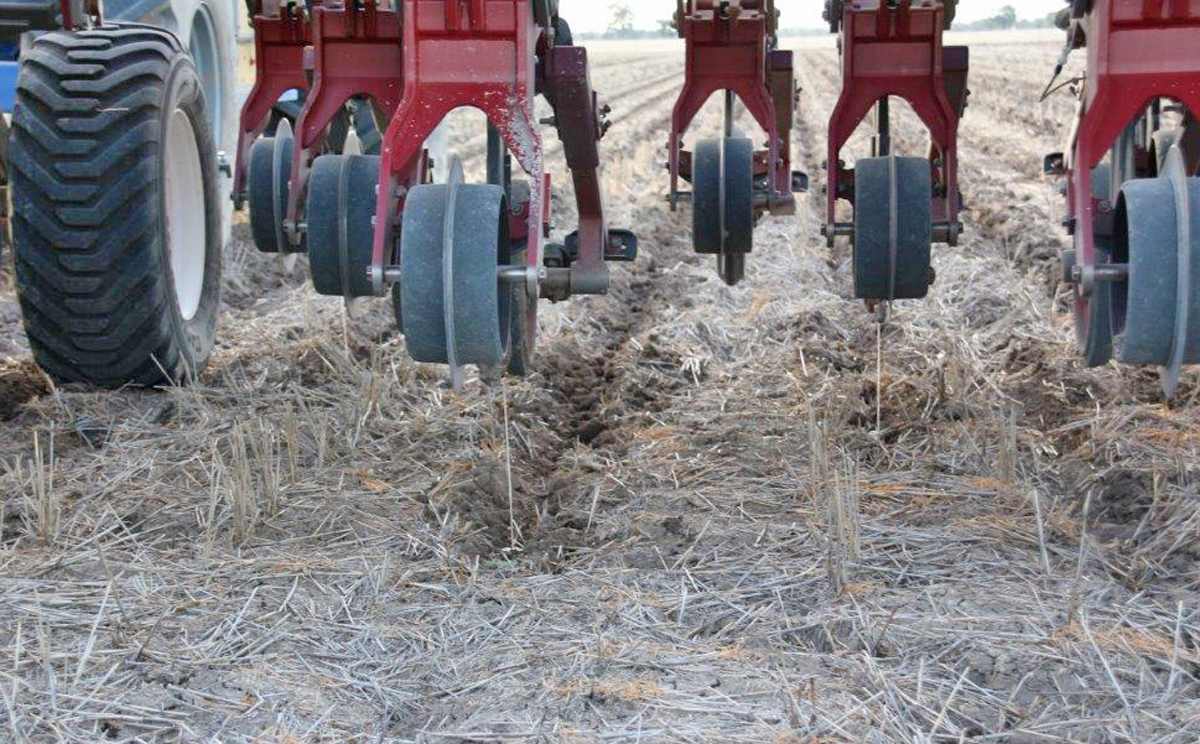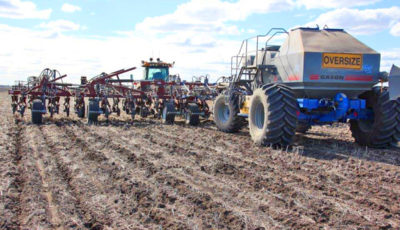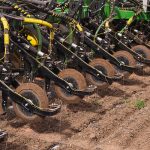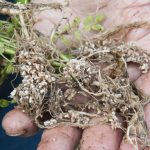Liquid application achieves incredible results
Since converting to a liquid system in 2012, New South Wales farmer Lee Lonergan has surpassed yield results by perfecting rates of UAN. Mungindi farmer Lee Lonergan has found his family property’s “sweet spot” for rates of Urea Ammonium Nitrate (UAN) applied in-furrow, yielding up to 1.5t/ha more on sections of his most marginal property in 2016.
“It’s critical for the liquid application to be very accurate to make the numbers work,” he said. “With this system, each seed gets just the right amount, so there’s no wastage and it’s applied right at the seed source.
| OUTCOMES |
|---|
- Double the average wheat yield in the 2016 season
- More than tripled the chickpea yield in the 2016 season, despite disease pressure
- Earlier germination: Seedlings 3-4 days faster than trial strips
- Vigorous growth: Initial growth 2-3 weeks ahead of trial strips
- Increased root development
- Improved soil structure
- Reduced fungicide applications, saving $10/ha per application
- Limited disease in chickpeas since spiking inoculants in-furrow
| EQUIPMENT USED |
|---|
- G22 DUAL INJECTION MODULE Information CLICK HERE
- SPIKER INJECTION MODULE Information CLICK HERE
- ON THE BAR (STACKER DISTRIBUTION)
- LIQUID 5 SECTION CONTROL Information CLICK HERE
- M5 DUAL STACKER (LQS-ACSD5) Information CLICK HERE
- TERMINAL ASSY – LQS-ATST Information CLICK HERE

Block Burren Downs – This block has always been a difficult block to achieve good yields. The liquids and trace elements are making a huge difference here. The distinct line in the paddock demonstrates where the liquid has been applied at 52Lt of UAN on the right and reduced to 35 Lt on the left. On the right it is darker and more consistent colouring. This crop is more consistent. Overall fungicide was applied on the seed and zinc at 4 L/ha at planting and 20L/ha foliar UAN was also applied.
The mixed enterprise farmer purchased Liquid Systems’ (SA) G22 and Spiker modules to apply liquid fertiliser, trace elements, fungicides and inoculant across his 4000ha cropping country.
Using his Liquid Systems (SA) G22 unit, Lee conducted a trial on his 1295ha Burren Down property last year, reducing the UAN application from 50L/ha to 35L/ha.
Mapping data shows a clear line in the paddock where wheat yield drops from about 5t/ha to approximately 3.5t/ha, where the reduced rate was applied.
“We did quite a few trials at Burren Down, which is our most marginal block, and the yield data shows that up extremely well,” said Lee. “You see a distinct cut off line where we reduced the UAN rate to 35L/ha.
“I’ve worked out over a number of years that 50L/ha is the most effective rate for us, especially on heavy based clay soils. Every year I’ve played around with the rate and found that every time I drop it below that amount, I see a yield reduction. I’ve done enough trials now to know what works. On lighter soils, I’ve found the rate can be reduced slightly while still maintaining good results. There is definitely a correlation between the soil type and the rate applied to maximise yield potential, plus there are benefits in using trace elements to improve the efficiency of fertiliser products.
“I think the secret is that with 50L/ha we give it enough stimulation to establish the plant. By putting small inputs down at the seed source, it sets the plant up to be healthy and structurally strong.”
Even reducing the rate by 10L/ha impacted yield last season on two adjacent blocks that received the same rainfall and were planted within 24 hours of one another. Block 4A (Above), a 191ha paddock which received 50L/ha, yielded nearly 1t/ha more than Block 4B (Above), which received 40L/ha of UAN. Lee also applied zinc in-furrow on both blocks using Liquid Systems’ (SA) Spiker module. The maximum or yield spike in these paddocks was also significantly different, with Block 4A yielding a maximum 9.16t/ha and Block 4B spiking at 7.22t/ha.
“The spike of 9.16t/ha is an out-of-this-world result,” said Lee. It’s equivalent to growing irrigated wheat for us.”
Yield increase: Last season’s bumper year even better than 1999
After five years of drought, the Lonergan’s received a welcome 415mm of rain during the 2016 season and crops responded with healthy yields. However, Lee believes applying liquid fertiliser is a major contributing factor to last season’s success. He compared the 2016 season with 1999 when they received 666mm of rain. “It was one of the best growing seasons on record for us,” said Lee. The farm averaged 3.6t/ha of wheat, across farming land that had received 100kg of urea planted in February. In 2016, the Lonergan farm yielded an average 4t/ha of wheat. “Last year, we received less rain than in 1999, but more yield,” said Lee. “While different varieties of wheat could have some bearing on this outcome, I think the basis of our success is that liquids give the plants the best opportunity to perform.
“It seems lots of people are becoming aware of what liquids offer now. Applying fertilisers, trace elements and all your inoculation in one pass is just smart business. And there’s no doubt that it pays for itself.”
Plant health: Improved germination, plant vigour & root development
Lee has applied UAN and either fungicide or zinc with his Liquid Systems (SA) unit at Burren Down for the past 5 years. While also experiencing a drought during this time, Lee saw improvements in germination, crop vigour and root development.
“The first time we used the Liquid Systems (SA) equipment we noticed that germination and plant vigour was significantly greater on the Burren Down soil,” said Lee.
“It’s a very clay-based soil; it’s what we call puggy soil, which makes it very hard to achieve good seed to soil contact. By using liquids, we found a significant improvement in germination straight away.
“You get an instant response. The plant came out of the ground probably three or four days faster than when we used urea.”
After germination, Lee noticed crops reaching the next stage of growth rapidly. “The plants spur on and grow to the next stage extremely quickly,” he said. “I’ve done trials on plant vigour, where I’ve turned the liquid system off and these plants have been about two or three weeks behind on that soil.”
A more established root system is another benefit Lee has seen due to liquid injection. “As the plant becomes more established, it develops a massive root system. It’s like the plant is on hormones,” he said. “This is exactly what you want in marginal country; a large root system to attract moisture and absorb nutrients or trace elements. It’s absolutely critical.
“When it comes to urea, I’ve used thousands of tonnes of urea over the years and you don’t achieve the root development at that early stage. Liquid fertiliser has a huge advantage in that area.”
Lee chooses to apply N42, a UAN product, via liquid injection and then apply top-up applications via foliar spraying when he is confident of a good season. “One of the benefits of using liquids in this format is that it allows you to do a foliar spray to top up your nitrogen if the season is reasonable,” said Lee. “It minimises the risk of high input costs up front.
“Previously we outlaid significant costs for fertiliser in February and prayed for rain. It’s a very high risk situation. Now, if we don’t get rain, we either make the choice not to fertilise or don’t plant at all.”
Chickpeas: Reduced disease and safer application
Liquid Systems’ (SA) technology has also transformed the way Lee protects his chickpea crops, by treating the seeds in-furrow. It’s not only safer for employees, the process has reduced chickpea disease on the Lonergan’s farm.
Previously, the process of mixing and coating seeds with inoculant caused OH&S issues and put the rhizobia at risk. “We would have to wear masks and suits during the mixing stage and then we only had three days to plant it before the rhizobia died. It put a lot of stress on us and frankly, I’m not sure we ever got it right,” said Lee.
“Now with the Liquid Systems (SA) unit, we can apply the inoculant with a one-pass operation, at the same time as planting and I can’t emphasise enough how well it works.”
Lee applies a mix of water and inoculant at a rate of 100L/ha. “I know that I’m getting very good coverage on my seed. I’m also wetting the ground where the seed germinates, so I’m protecting the seedling at germination. This excites me no end, because I just know I’m going to get a good start and I’ve had limited disease ever since I’ve started doing it.
“Before we went to this method, we were getting yellow spots on the leaves very early in the crop’s life and in no time at all we were applying fungicides. Last season, chickpeas were open to disease because of all the rain and normally it would have been enough to almost kill the crop. But ours kept growing. Plus, we were about three fungicide sprays behind other farmers in the district. Two farmers close by did seven sprays, while we did four and we were all planting on the same day. At $10/ha for fungicide, there are dollar savings there.”
Yield results reveal the effectiveness of Lee’s liquid strategy with chickpeas. Despite last year’s rainfall of 415mm, Lee yielded an average 3.5t/ha of chickpeas, triple the usual amount.
“Normally if we grow anywhere near 1t/ha of chickpeas we’re content. The fact that it was a trying year for chickpeas, which don’t like wet feet, my average of 3.5t/ha is incredible.”
Reduced input costs: The importance of accuracy
Lee believes the level of accuracy achieved by the Liquid Systems (SA) equipment is “crucial” to his farm’s bottom line. “Because of the cost of liquids, it’s critical for the liquid application to be very accurate to make the numbers work,” he said. “With Peter’s system, each seed gets just the right amount, so there’s no wastage and it’s applied right at the seed source.
“There’s a huge misconception about the cost ratio of liquids versus granular,” he said. “With any granular product, you are putting out double the amount to get the same result as with liquids, because liquid fertiliser is in a form that the plant can access. You can’t compare unit for unit price. We would normally use 46 units of nitrogen to grow a 2.4t/ha crop. In liquid form, we use 22 units and have substantially better crops.”











